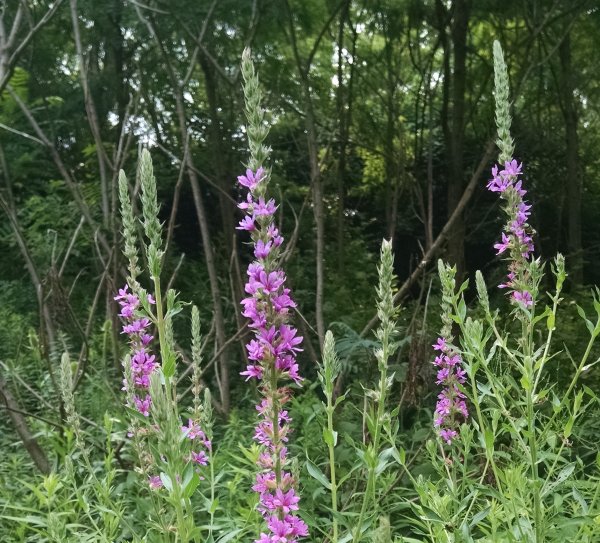
When I saw this plant blooming in Schenley Park the other day I made sure to point it out to participants at last Sunday’s walk. Most people aren’t aware that purple loosestrife (Lythrum salicaria) is highly invasive.
Purple loosestrife came to North America from Europe and was established on the east coast by the mid 1800s. It grows 1.5 to 5 feet tall with opposite or alternate untoothed leaves and a spike of pinkish purple flowers. Here’s a closeup of the flower.
It spreads by seed and by massive woody roots in ditches, wet meadows and wetlands. Once it takes hold it out-competes native plants and creates a monoculture that lowers the biodiversity of the site. Amazingly it even affects ducks because, though dense at the top, it’s open at water level and provides no cover for nesting.
Purple loosestrife is listed as invasive in 27 states, including Pennsylvania, but many garden stores and garden websites still sell it to those who are unaware of the danger. When its seeds get into flowing water, watch out!
Fortunately years of research found a beetle that eats it. In the video below, Donna Ellis from the University of Connecticut Cooperative Extension describes purple loosestrife and how the Galerucella beetle is an effective biological control agent. (Birders, listen to the audio track. If I’d been standing there I would have been totally distracted by those upset birds!)
I found only a single loosestrife in Schenley Park and an Urban Eco Steward pulled it up (yay!) but on Thursday I found two clumps on Carnegie Mellon’s campus. Uh oh!
Pretty. Invasive.
(photo by Kate St. John)
Hi Kate
Not sure of how to contact you so posting here a bbc piece on the Peregrines: http://www.bbc.com/earth/story/20150626-the-predator-ruling-uk-city-skiesAnd yes the purple was “dealt with”!
Paula
Paula, thanks for ‘pulling the purple.’
One small patch at Duck Hollow but tons of it lining the hiker/biker trail down by the Hays eagle nest. I can take care of Duck
In addition to being weedy and persistent, purple loosestrife is a regulated in PA, under the Noxious Weed Law.
Excerpted from the Noxious Weed Law summary:
“Section 4. Sale or Propagation.
When a weed is declared noxious it shall be a violation of this act to sell, transport, plant, or otherwise propagate that weed within the Commonwealth, except that the secretary may permit exceptions for specific horticultural or experimental use.”
From PDA’s purple loosestrife brochure:
“The Pennsylvania Department of Agriculture added the Lythrum salicaria Complex: Any nonnative Lythrum in-cluding, Lythrum salicaria and Lythrum virgatum, their cultivars and any combination thereof; to the PA Noxious Weed Control list in 1997.”
In addition to managing it on your own property and those precious to you, if you encounter businesses selling purple loosestrife or its cultivars, you should make known to them they are in violation of the law, and report them to the PA Department of Agriculture if they are disinclined to desist.